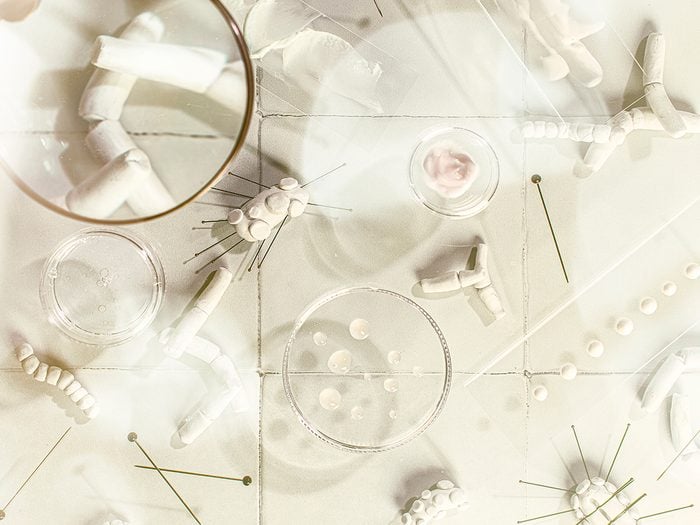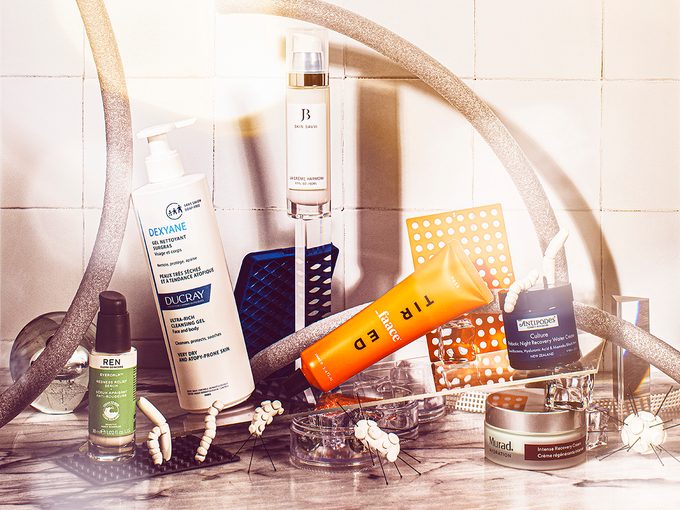6 Microbiome-Boosting Skin Care Products You Never Knew You Needed

You know probiotics are good for your gut, but did you know they can benefit your face too?
Probiotics can help your skin microbiome, which is a trending topic that’s been gaining momentum over the past few years and is now taking over shelves. A healthy microbiome equals healthy skin, says Jennifer Brodeur, a Quebec-based celebrity facialist and the founder of JB Skin Sävvi.
Propelled by a global pandemic that has fuelled a fixation on germs and increased occurrences of stressed-out skin, the science of skin health has never been buzzier. “Through recent developments in microbiology, we can obtain very specific genetic-based information about the skin,” says Dr. Nazli Ghiasi, a dermatologist, the owner of MapleDerm and an assistant professor of medicine at the University of Toronto. “This has advanced our understanding of what constitutes a healthy versus unhealthy skin microbiome.”
While Brodeur has kept tabs on the bubbling topic for over a decade, she expects the conversation to blow up in the future. “The power of the microbiome on skin health is big,” she says, citing The Beauty of Dirty Skin: The Surprising Science of Looking and Feeling Radiant from the Inside Out, written by Dr. Whitney Bowe in 2018, as a recent amplifier. “Her patients with the most severe skin conditions had gastrointestinal challenges as well. Microbial inhabitants can influence how your skin behaves,” Brodeur says.
Sounds like important information for anyone who wants to advocate for their own health. Where do you go from here? Let’s start from the beginning.
(Related: 13 Foods High in Natural Probiotics)
What exactly is the skin microbiome?
While your skin acts as a physical barrier between you and the larger world, there’s a whole host of activity happening on a much smaller scale. “Various types of microbes are everywhere in the environment. They’re present on all living organisms, including plants, and they’re also present on the surface of the skin,” says Ghiasi. This ecosystem is called the skin microbiome. It contains over one trillion micro-organisms that coexist within it that are generally divided into two types: commensal (or normal) and pathogenic (or disease-causing).
“Good skin includes a friendly, diverse array of bacteria, viruses and fungi,” says Brodeur. “They literally make their home on the skin. The skin is sterile in utero, but colonization occurs immediately after birth.” This array of micro-organisms makes your skin’s microbiome unique to you. “These micro-organisms all have essential roles in the protection against invading pathogens, the education of our immune system and the breakdown of natural products,” she says.
What are the warning signs of a compromised microbiome?
Understanding the role your microbiome plays in skin health can shed light on what you’re seeing or feeling in your epidermis. “A compromised microbiome can lead to dryness, overproduction of sebum, breakouts, itchiness and redness,” says Brodeur. This includes anyone who suffers from common skin conditions, such as psoriasis, atopic dermatitis or rosacea. “There are several studies from the past few years that suggest abnormal microbiota on human skin have a large impact on inflammatory skin conditions, particularly acne and eczema,” Ghiasi says.
Regardless of the condition, bad microbes start running the show, causing inflammation and hindering the growth of good microbes. “This leads to a loss of microbial diversity, which is a key component of healthy skin,” she says.
How can you improve your microbiome?
The first step to maintaining a balanced skin microbiome is to start feeding it well. “A mix of prebiotic, probiotic and postbiotic ingredients is the best approach,” says Brodeur. Prebiotics (which feed skin’s probiotic bacteria) include oat extract, glycerol (AKA glycerine), rhamnose and oligosaccharides, while lactobacillus, lactococcus, bifidobacterium and vitreoscilla are common probiotics. The list of postbiotic ingredients, those derived from the fermentation of living bacteria, includes hyaluronic acid, peptides and ceramides.
“It is also very important to keep your skin well hydrated, especially in the drier months, by using a good moisturizer,” says Ghiasi. “Broken skin is often susceptible to penetration and overgrowth of pathogenic bacteria.” She recommends removing makeup nightly but avoiding harsh soaps that can overly strip the skin’s barrier. “Do not leave excess oil and residue on the skin. This makes you more prone to the overgrowth of yeast.
It is essential to routinely wash makeup brushes and anything else that comes in contact with your skin, like a pillowcase,” Ghiasi says. Brodeur’s checklist includes using sunscreen to help maintain the delicate homeostasis of the skin and avoiding unnecessary treatments that can be irritating and drying.
What else do we know about the microbiome?
Our understanding of the deeper impact of the skin’s microbiome on overall health is a work in progress. “At present, we do not understand very well how skin microbes may impact gut flora, but there are some studies to suggest that prebiotics and probiotics in the diet may help with skin disease, such as acne,” says Ghiasi.
As someone affected by celiac disease, an autoimmune disease triggered by gluten, Brodeur has experienced the link between diet and skin first-hand. “The relationship of the skin-gut axis is fascinating. And the connection is important if we want to better understand what our skin is trying to tell us,” she says. Brodeur encourages eating a healthy diet. “You can add more foods that contain prebiotics, such as oats and legumes, and probiotics such as yogurt.”
And stay tuned as science reveals more about this vital inside-out correlation. “We do know that inflammation in any organ in the body can increase risk of other inflammatory conditions,” says Ghiasi, “so it is safe to say that an interplay of healthy gut and skin microbiome likely promotes overall well-being.”

6 microbiome skin care products to try
A soap- and fragrance-free formula cleanses while soothing even the driest skin.
Ducray Dexyane Ultra-Rich Cleansing Gel, $24, pharmacies across Canada and shoppersdrugmart.ca
This dreamy blend of probiotics and hyaluronic acid tends skin while you sleep.
Antipodes Culture Probiotic Night Recovery Water Cream, $70, well.ca
Glycerin (hydrating) and lactic acid (exfoliating) give lacklustre skin a gentle boost.
Faace Tired Mask, $45, detoxmarketcanada.com
Calm multiple symptoms of sensitive skin while reducing redness fast.
REN Evercalm Redness Relief Serum, $68, sephora.com
Treat blemish-causing bacteria and restore balance to skin.
JB Skin Sävvi La Crème Harmoni, $95, jbskinsavvi.com
Here’s an ultra-rich way to deeply comfort a dry, stressed-out complexion.
Murad Intense Recovery Cream, $109, muradskincare.ca
Now that you know about microbiome skin care products, learn if you’re layering skin care products the right way.




